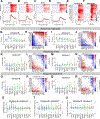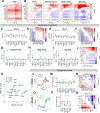Neural dynamics in the limbic system during male social behaviors
- PMID: 37586365
- PMCID: PMC10592239
- DOI: 10.1016/j.neuron.2023.07.011
Neural dynamics in the limbic system during male social behaviors
Abstract
Sexual and aggressive behaviors are vital for species survival and individual reproductive success. Although many limbic regions have been found relevant to these behaviors, how social cues are represented across regions and how the network activity generates each behavior remains elusive. To answer these questions, we utilize multi-fiber photometry (MFP) to simultaneously record Ca2+ signals of estrogen receptor alpha (Esr1)-expressing cells from 13 limbic regions in male mice during mating and fighting. We find that conspecific sensory information and social action signals are widely distributed in the limbic system and can be decoded from the network activity. Cross-region correlation analysis reveals striking increases in the network functional connectivity during the social action initiation phase, whereas late copulation is accompanied by a "dissociated" network state. Based on the response patterns, we propose a mating-biased network (MBN) and an aggression-biased network (ABN) for mediating male sexual and aggressive behaviors, respectively.
Keywords: aggression; estrogen receptor alpha expressing cells; limbic system; mice; multi-fiber photometric recording; sexual behaviors.
Copyright © 2023 Elsevier Inc. All rights reserved.
Conflict of interest statement
Declaration of interests The authors declare no competing interests.
Figures







References
Publication types
MeSH terms
Grants and funding
LinkOut - more resources
Full Text Sources
Molecular Biology Databases
Miscellaneous

